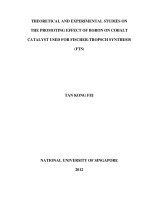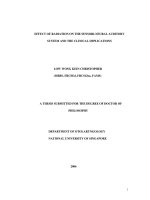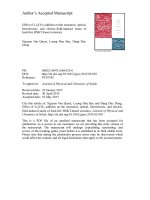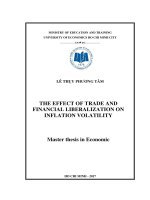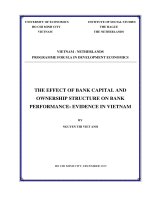Isoflavone levels and the effect of processing on the content of isoflavones during the preparation of soymilk and tofu
Bạn đang xem bản rút gọn của tài liệu. Xem và tải ngay bản đầy đủ của tài liệu tại đây (1.23 MB, 200 trang )
ISOFLAVONE LEVELS AND THE EFFECT OF
PROCESSING ON THE CONTENT OF ISOFLAVONES
DURING THE PREPARATION OF SOYMILK AND
TOFU
MOLAMMA P PRABHAKARAN
B.Sc (Tech), UDCT, Mumbai.
A THESIS SUBMITTED
FOR THE DEGREE OF DOCTOR OF PHILOSOPHY
FOOD SCIENCE AND TECHNOLOGY PROGRAMME
DEPARTMENT OF CHEMISTRY
NATIONAL UNIVERSITY OF SINGAPORE
2005
i
ACKNOWLEDGMENTS
I would like to take this opportunity to express my sincere gratitude to my supervisors,
Dr. Conrad O Perera and Dr. Suresh Valiyaveettil for introducing me to the field of
phytochemicals and for placing outstanding working facilities at my disposal. I am
deeply grateful to them for their support, encouragement, patient guidance and
suggestions in bringing this thesis to completion. I am also thankful to Dr. Philip J
Barlow for his continuous support and advice during this research tenure.
Thanks are also given to my colleagues in the Food Science & Technology programme,
and especially to Dr. Lina Goh, Ms. Nang Sabei Myint and Ms. Mya Mya Khin, who
have given me great help in my research work. I would like to thank Ms. Ravinder Kaur
from Unicurd Food Company in helping to carry out different soy based preparations and
for providing the samples. I appreciate the great help from Madam Lee Chooi Lan for
her numerous acts of help in solving day to day laboratory problems. Special thanks also
go to ADM Company, USA for providing me with a free gift of defatted soy flour during
this research work. I am grateful to the National University of Singapore for providing
me the research scholarship and funds to let me have this great opportunity to complete
this research study.
I am extremely grateful to my family members and especially to my husband, Mr. Biju
Nair for his substantial support with endless love, advice and encouragement in my life.
Last but not least, many thanks to all those who have contributed in one-way or another
in making this thesis possible.
ii
TABLE OF CONTENTS
Acknowledgements i
Table of Contents ii
Summary viii
List of Tables x
List of Figures xii
Abbreviations xiii
List of Publications xiv
PART I INTRODUCTION AND EXPERIMENTAL………………………………1
Chapter 1 Introduction and literature review………………………………………….…2
1.1 Soybean……………………………………………………………………………… 2
1.1.1 Origin of soybeans………………………………………………………… 2
1.1.2 Agronomic characteristics.………………………………………………….2
1.1.3 Composition of soybean.………………………………………………… 3
1.2 Soy foods…………………………………………………………………………… 4
1.2.1 Soymilk…………………… ……………………………………………….4
1.2.1.1 Composition of soymilk………………………………………… 5
1.2.1.2 Status of soymilk in Asian countries…………………………… 6
1.2.1.3 Soymilk preparation methods.…………………………………….7
1.2.1.4 Soy pulp or Okara – the byproduct during soymilk making…… 12
1.2.2 Tofu……………………………………………………………………… 13
1.2.2.1 Types of tofu…………………………………………………… 14
iii
1.2.2.2 Tofu coagulants………………………………………………… 15
1.2.2.3 Tofu gelation mechanism……………………………………… 16
1.2.2.4 Factors affecting the quality attributes of tofu……………… 16
1.2.2.5 Tofu wheys……………………………………………………….18
1.2.3 Other soy based products.………………………………………………….18
1.2.3.1 Soy supplements and health products.………………………… 18
1.2.3.2 Soy based infant formulas.…………………………………….…20
1.3 Isoflavones.………………………………………………………………………… 22
1.3.1 Isomers, structure and occurrences……………………………………… 23
1.3.2 Soy and role of isoflavones in disease prevention…………………………25
1.3.2.1 Soy intake and heart disease…………………………………… 26
1.3.2.2 Soy intake and menopause……………………………………….27
1.3.2.3 Soy intake and bone health…………………………………… 28
1.3.2.4 Soy intake and breast health…………………………………… 29
1.3.2.5 Major concerns about soy supplements and health products.……30
1.3.3 Isoflavones as phytoestrogens…………………………………………… 31
1.3.4 Absorption and metabolism……………………………………………… 32
1.3.5 Adverse effects of phytoestrogens…………………………………………34
1.4 Soy isoflavones – analysis and processing effects.…………………………….……35
1.4.1 Methods for extraction and analysis of soy isoflavones………………… 35
1.4.2 Concentration of isoflavones in soybeans and soy foods…… ………… 37
1.4.3 Effects of processing on isoflavone levels…………… 39
1.4.4 Methods for reporting the concentration of isoflavones ………………… 42
iv
1.5 Objectives of the study…………………………………………………………….…43
Chapter 2 Materials and methods………………………………………………………45
2.1 Materials ………………………………………………………………………… 45
2.1.1 Chemicals……………………………………………………… ……… 45
2.1.2 Food materials.…………………………………………………………… 46
2.1.2.1 Commercially available brands of soymilk and tofu samples.… 46
2.1.2.2 Preparation of soymilk – traditional method.……… ………… 46
2.1.2.3 Preparation of soymilk – UHT processing system.…………… 47
2.1.2.4 Preparation of tofu……………………………………………….51
2.1.2.5 Soy supplements, health products and infant formulas………….52
2.2 Methodologies adopted.…………………………………………………………….54
2.2.1 Sampling procedure ……………………………………………………….54
2.2.1.1 Soybean seeds………………………………………………… 54
2.2.1.2 Sampling of soymilk, tofu, whey and related products………….54
2.2.1.3 Sampling of soy supplements, health products and infant formulas
………………………………………………… 55
2.2.2 Moisture analysis………………………………………………………… 55
2.2.3 Protein assay …………………………………………………………… 56
2.2.3.1 Measurement of protein in soy based samples………………… 58
2.2.4 Yield of tofu……………………………………………………………… 58
2.2.5 Texture measurement………………………………………………………59
2.2.5.1 Principle of texture measurement…………………………….….59
v
2.2.5.2 Method used for texture analysis of tofu……………………… 61
2.2.6 Color analysis………………………………………………………………61
2.2.6.1 Principle of color analysis…………………………………… …61
2.2.6.2 Color analysis of tofu ……………………………………………63
2.2.7 pH measurement.………………………………………………………… 63
2.2.8 Isoflavone analysis.……………………………………………………… 64
2.2.8.1 Method adopted for extraction of isoflavones from soy samples 64
2.2.8.2 Optimization of gradient profile for HPLC analysis of isoflavones
……………………………………………………….….67
2.2.8.3 Calibration curve for isoflavone standards…………………… 70
2.2.8.4 Isoflavone structure confirmation by LC-MS………………… 71
2.2.8.5 Procedure for calculation and expression of isoflavone amounts 71
2.2.9 Statistical analysis of data………………………………………………….74
PART II RESULTS AND DISCUSSIONS…… 75
Chapter 3 Method application for the quantification of isoflavones in soy based foods 76
3.1 Application of method developed for isoflavone analysis………………………… 76
3.2 Results of LC-MS analysis of isoflavones………………………………………… 79
3.3 Quantification of isoflavones in soymilk…………………………………………….84
3.3.1 Isoflavone concentrations in soymilk samples from Singapore………… 84
3.3.2 Isoflavone concentrations in soymilks from other South East Asian countries
……………………………………………….… 86
3.4 Quantification of isoflavones in tofu……………………………………………… 89
vi
3.4.1 Isoflavone contents in commercially available tofu samples from Singapore
…………………………………………… 89
3.4.2 Isoflavone concentrations in tofu samples from other South East Asian
countries………………………………………………………………… 92
3.5 Discussion on the results of isoflavone analysis…………………………………… 94
Chapter 4 Effect of extraction methods and UHT treatment conditions on the level of
isoflavones during soymilk manufacture.……………………………………………… 98
4.1
Isoflavone levels in soymilk prepared by hot-grind versus cold-grind method…… 99
4.2 Isoflavone levels in soymilk subjected to direct versus indirect UHT treatment… 108
4.3 Okara and isoflavone losses……………………………………………………… 109
4.4 General discussion……………………………………………………………… 112
Chapter 5 Effect of different coagulants on the isoflavone levels and physical properties
of firm tofu………………………………………………………………………….… 114
5.1 Effect of different coagulants on the isoflavone levels in tofu.………………….…115
5.2 Effect of different coagulants on the physical properties of tofu………… …….…120
5.2.1 Evaluation of yield, moisture and color of tofu………………………… 121
5.2.2 Evaluation of the textural properties of tofu…………………………… 123
5.3 Evaluation of the expelled tofu wheys…………………… ………………………126
5.3.1 Tofu wheys and its pH effect…………………………………………… 126
5.3.2 Isoflavones in tofu wheys…………………… …………………………129
vii
Chapter 6 Concentration and profile of isoflavones in soy based supplements, health
products and infant formulas: evaluation of its level of intake………………… ….….132
6.1 Isoflavones in soy supplements…………………………………………………….133
6.2 Isoflavones in soy based health products……………………………………… ….137
6.3 Isoflavones in soy based infant formulas………………………… ……………….143
6.4 Evaluation of product labels, contents, intake and need for standardization of
isoflavone levels…………………………………………………………………….… 146
PART III CONCLUSIONS AND FUTURE RESEARCH……………………… 148
Chapter 7 Conclusions and future research…………………………….…………… 149
7.1 Conclusions………………………………………………………………….…… 149
7.2 Suggestions for future research………………………………………………… …151
REFERENCES…………………………………………………………… ………….153
APPENDICES … 181
viii
SUMMARY
Isoflavones are phytoestrogens, belonging to a group of phenolic compounds found in
soybeans and soy foods. The parent isoflavones in soybeans are genistein, daidzein and
glycitein, while their respective glucosides are genistin, daidzin and glycitin. Others
include their corresponding acetyl and malonyl glucosides. These compounds have been
associated with the decreased incidence of different types of cancers, cardiovascular
diseases and osteoporosis. With the several health benefits associated with these
compounds, this research work was set out to examine the effect of processing on the
content and composition of isoflavones in different soy products during their manufacture
as well as to study the content and composition of various soy based health products,
supplements and infant formulas.
Initial investigations were aimed at choosing an ideal method for efficient extraction of
isoflavones, followed by its quantification. An RP-HPLC method was developed and it
was applied for the quantification of isoflavones in different soy based products, which
proved successful. LC-MS using ESI interface, was further used for the peak
identification studies.
Evaluation of the effect of different extraction methods and UHT heat treatments on
isoflavones in the prepared soymilks was carried out. Samples were drawn at different
points during the processing and were analyzed for their isoflavone concentrations.
Results showed that hot grinding caused a higher extraction of isoflavones into the
ix
soymilk than cold-grinding process. However, direct or indirect heating in the UHT
process did not cause a difference in the concentration of isoflavones in the final soymilk
obtained. Tofu was made by the coagulation of soymilk with salt or acid to produce a soy
protein gel which traps water, soy lipids and other constituents in the matrix. Firm tofu
was prepared using different coagulants and the quantification of isoflavones in the tofu
and separated whey were carried out. This study further evaluated the yield and physical
properties such as the moisture, texture and color of tofu prepared from different
coagulants. Among the different coagulants studied, calcium sulfate was identified as the
most suitable coagulant for tofu making in terms of its high yield, retention of maximum
amount of isoflavones and in obtaining a firm, but smooth tofu. Selecting an appropriate
processing condition can therefore result in retaining higher amounts of isoflavones in the
soy products; soymilk or tofu, thus reducing their loss into the by-products of the process.
Analysis of isoflavones in different soy based health products and supplements were also
carried out, and the possible isoflavone intake, calculated according to the recommended
dosage levels showed a higher degree of variability from product to product. Similarly,
soy based infant formulas had wide variations in their isoflavone levels. This research
also highlights the need for expressing the concentration of isoflavones in a standardized
manner, namely, in aglycone equivalent concentrations to minimize the differences in the
molecular weights of the different isoflavones in different products.
x
LIST OF TABLES
Table 1.1: Average chemical composition of soybean seed (dry weight basis)……………… ….3
Table 1.2: Composition of soymilk, cow’s milk and human breast milk…………………… … 5
Table 1.3: Soymilk standards followed in Asian countries…………………………………… 7
Table 1.4: Processes used for the extension of shelf life of soymilk………………………… 10
Table 1.5: Protein, fat, crude fiber and carbohydrates in okara expressed on a dry weight basis 12
Table 2.1: Identification of the different soy isoflavone supplements involved in the study…….53
Table 2.2: HPLC gradient developed for soy isoflavone analysis and separation……………… 69
Table 2.3: Aglycone conversion factors………………………………………………………….73
Table 3.1: Ions observed in positive and negative ion spectra of isoflavone glucosides and
aglycones, generated by ESI – MS……………………………………………………………….79
Table 3.2: Total isoflavone data (on wet weight basis) reported as µg aglycone equivalents per
gram of the sample for commercially available soymilks from Singapore………………………85
Table 3.3: Total isoflavone data (on wet weight basis) reported as µg aglycone equivalents per
gram of sample for the commercially available soymilks from Malaysia, Indonesia and Thailand
…………………………………………………………………………………………………….87
Table 3.4: Total isoflavone data (on wet weight basis) reported as µg aglycone equivalents per
gram of the sample for the commercially available tofus from Singapore market…………….…90
Table 3.5: Total isoflavone data (on wet weight basis) reported as µg aglycone equivalents per
gram of sample for the commercially available tofu samples from Malaysia, Indonesia and
Thailand……………………………………………………………………………………….….93
Table 4.1: Isoflavone concentrations reported on a dry matter basis, in various samples of a hot
grind process trial…………………………………………………………………………… …102
Table 4.2: Isoflavone concentrations reported on a dry matter basis, in various samples of a cold
grind process trial……………………………………………………………………………… 103
Table 4.3: Isoflavone concentrations reported on a dry matter basis, in various samples of the
duplicate hot grind process trial…………………………………………………………………104
Table 4.4: Isoflavone concentrations reported on a dry matter basis in various samples of the
duplicate cold grind process trial…………………………………………………….………….105
Table 5.1: Comparison of isoflavone contents in soybean curds prepared using different
coagulants……………………………………………………………………………….………117
xi
Table 5.2: Yield, moisture and color of tofus prepared using different coagulants……… ……121
Table 5.3: Textural properties of tofu prepared using different coagulants……………….……124
Table 5.4: Amount, pH and isoflavone contents in the wheys collected during tofu preparations…
………………………………………………………………………………………………… 127
Table 6.1: Isoflavone concentrations in commercially available soy supplements, expressed as µg
aglycone equivalents per gram of the product………………………………………………… 133
Table 6.2: Isoflavone concentrations per gram of the product and the amounts obtained from a
serving of the commercially available soy based health products, expressed in aglycone
equivalents …………………………………………………………………………………… 138
Table 6.3: Isoflavone amounts in different ready-to-drink products, expressed as µg aglycone
equivalents per gram of the product. ………………………………………………………… 140
Table 6.4: Isoflavone concentrations in commercially available soy based infant formulae
expressed in µg aglycone equivalents per gm of the product in powder form………………….144
Table 6.5: Daily intake of isoflavones by infants (categorized based on their age) after consuming
different soy based infant formulae, expressed in mg aglycone equivalents…………….… ….145
xii
LIST OF FIGURES
Figure 1.1: Schematic diagram for production of soymilk and tofu ………………………………6
Figure 1.2: Structure of flavone versus isoflavone.…………………………………………… 22
Figure 1.3: Chemical structures of 12 soy isoflavones ……………………………………….….23
Figure 1.4: Structure of estradiol ……………………………………………………………… 31
Figure 2.1: Flow diagram for the processing of soybeans to soymilk.………………………… 50
Figure 2.2: Texture profile analysis curve from ‘two-bite test’…………………….……………60
Figure 2.3: CIE L*, a*, b* color space………………………………………………….…… …63
Figure 3.1: Representative HPLC chromatogram of the six isoflavones in soy samples……… 77
Figure 3.2: MS spectra of soy isoflavone glucosides and their respective aglycones.……….….83
Figure 3.3: Correlation of protein and isoflavone levels for soymilk samples.……………… …86
Figure 3.4: Protein-isoflavone relationship in tofu samples…………………………………… 91
Figure 4.1: Comparison of isoflavone levels in soybean seed and okara during the hot and cold
grinding trials and from a traditional soymilk process………………………………………….110
Figure 5.1: Typical texture profile analysis curve obtained for a firm tofu…………………….123
Figure 6.1: Comparison of the amount of isoflavones per tablet or capsule and the possible daily
intake of isoflavones, expressed in aglycone equivalents for the different soy isoflavone
supplements…………………………………………………………………………………… 135
Figure 6.2: Total isoflavone amounts obtained from a serving of the different ready-to-drink
products.…………………………………………………………………………………… 141
xiii
ABBREVIATIONS
BSA Bovine serum albumin
CIE Commission International de L'Eclairage
DAD Diode array detector
ERβ Estrogen receptor beta
ESI-MS Electrospray ionization- mass spectrometry
GC-MS Gas chromatography- mass spectrometry
GDL Glucono-δ-lactone
HCl Hydrochloric acid
HDL High density lipoprotein
Hg Mercury
HPLC High performance liquid chromatography
HRT Hormone replacement therapy
LDL Low density lipoprotein
LMW Low molecular weight
LOX Lipoxygenase
MS Mass spectrometry
NaOH Sodium hydroxide
6OAcGlc 6''-O-acetyl glucoside
6OMalGlc 6''-O-malonyl glucoside
ODMA O-desmethylangolensin
PDA Photo diode array
RP- HPLC Reversed phase- high performance liquid chromatography
SBIF Soy based infant formula
SD Standard deviation
SPI Soy protein isolate
TFA Trifluroacetic acid
TI Trypsin inhibitor
TPA Texture profile analysis
UHT Ultra high temperature
UV Ultra violet
xiv
LIST OF PUBLICATIONS AND CONFERENCE PAPERS
1. Molamma P Prabhakaran, Conrad O Perera, Suresh Valiyaveettil. Quantification of
isoflavones in soymilk and tofu from South East Asia. Inter. J. Food Properties, 8,
113 -123, 2005.
2. Molamma P Prabhakaran, Conrad O Perera, Suresh Valiyaveettil. Effect of different
coagulants on the isoflavone levels and physical properties of prepared firm tofu.
Food Chemistry, 2005 (article in press and available online from 5 Oct, 2005).
3. Molamma P Prabhakaran and Conrad O Perera. Effect of extraction methods and
UHT treatment conditions on the level of isoflavones during soymilk manufacture.
Food Chemistry, 2005 (article in press and available online from 5 Oct, 2005).
4. Molamma P Prabhakaran, Conrad O Perera, Lim Soo Hui. Evaluation of the
composition and concentration of isoflavones in soy based supplements, health
products and infant formulas. Food Research International, 39, 730 - 738, 2006.
5. Molamma P Prabhakaran and Conrad O Perera. Fractionation of isoflavones during
the pilot plant scale preparation of soymilk, silken tofu and a firm tofu manufacturing
process. 10th World Congress on Clinical Nutrition. Nov 30- Dec 3, 2004, Phuket,
Thailand.
6. Molamma P Prabhakaran and Conrad O Perera. Quantification of isoflavones in little
investigated and commonly consumed soy foods in Singapore. International Food
Conference, July 15 -18, 2004, Las Vegas, USA.
7. Molamma P Prabhakaran, Tay, S. L., Chin, C. Y., Imran, N., Conrad O Perera. Effect
of extraction and UHT treatment conditions on isoflavones and protein-quality during
xv
soymilk manufacture. International Food Conference, July 15 -18, 2004, Las Vegas,
USA.
8. Molamma P Prabhakaran and Conrad O Perera. Development of a high performance
liquid chromatographic method for the analysis of isoflavones in soy foods. Regional
Conference for young Chemists. , April 13 -16, 2004, Penang, Malaysia.
9. Molamma P Prabhakaran Conrad O Perera, Suresh Valiyaveettil. Development and
application of a high performance liquid chromatographic method for the analysis of
isoflavonoids in soy containing foods. Singapore International Chemical Conference
3: Frontiers in Physical and Analytical Chemistry, p80, Dec. 29-30, 2003, Singapore.
10. Molamma P Prabhakaran and Conrad O Perera. Isoflavone levels in soy foods
consumed by Singaporeans. The 2
nd
Asia-Pacific conference and Exhibition on Anti-
Aging Medicine, p10, Sep. 8-11, 2003, Singapore.
11. Molamma P Prabhakaran and Conrad O Perera. Isoflavones in soy foods. HSA-NUS
Joint Seminar: Collaborative Research in Health Sciences, Apr 8-10, 2003,
Singapore.
1
PART I
INTRODUCTION AND EXPERIMENTAL
2
CHAPTER 1
INTRODUCTION AND LITERATUR REVIEW
1.1 SOYBEAN
1.1.1 Origin of soybeans
Soybeans are believed to have originated in China 4000-5000 years ago. The first written
record of the plant was contained in the book Materia Medica by the Chinese emperor
Shen Nong in about 2838 B.C. (Anonymous, 1993). The soybean was considered one of
the five sacred grains, along with rice, wheat, barley and millet essential to Chinese
civilization. However large-scale production of soybean varieties did not occur until the
1920’s. Since that time, world production of soybeans has increased by 400%
(Anonymous, 1993). Much of the demand for soybeans in the United States, other
developed countries and in many Asian countries derives from its popularity as a cooking
oil source and as a base for margarine and other consumer products.
1.1.2 Agronomic characteristics
Botanically, soybean belongs to the family Leguminosae, subfamily Papilionoideae and
the genus Glycine, L (Liu, 1997). The cultivated form, called Glycine max (L.) Merrill,
grows annually. The seeds are nearly spherical in shape with an average seed weight of
120-180mg. Soybean is well known for its variation in physical properties as well as in
its chemical composition (Liu, 1997).
3
1.1.3 Composition of soybean
An excellent source of good quality protein, the soybean consists of about 38 percent
protein, which is about double the protein content of even the other protein-rich legumes;
18% oil, 15% soluble carbohydrates, 15% insoluble carbohydrates and 14% other
components (moisture and ash). The average chemical composition of soybean seed on a
dry weight basis is shown in Table 1.1 (Liu, 1997).
Table 1.1: Average chemical composition of soybean seed (dry weight basis)
Whole soybeans U .S. soybeans (%) Japanese soybeans (%)
Crude protein 40.70 39.20
Crude fat 22.50 18.40
Carbohydrate 31.90 37.40
Ash (mineral) 4.90 5.00
Most plant sources are deficient in one or more of the essential amino acids. Soybean is
no exception and is limiting in methionine, followed by cyst(e)ine and threonine (Eggum
and Beames, 1983). However, soy protein contains sufficient lysine, which is deficient in
most cereal proteins. It is also unique because of the presence of isoflavones. Isoflavones
have an extremely limited distribution in nature, while soybeans and soy foods can be
considered as the major natural dietary sources of these compounds (Coward et al.,
1993). Increasing evidence has indicated that soybeans might have cancer-preventive
properties by epidemiological (Adlercreutz et al., 1986; Lee et al., 1991), animal
(Baggot et al., 1990) and in vitro (Adlercreutz et al., 1992; Wei et al., 1993) studies.
Results from these studies have suggested that the isoflavones might be the contributing
factors in prevention of cancer. These compounds also possess estrogenic (Miksicek,
1993), antioxidative (Naim et al., 1976; Wei et al., 1993) and antifungal
4
(Weidenborner et al., 1990) properties. Recently there has been much interest among
clinicians and researchers, in the potential role of soybeans and soy foods in preventing
and treating chronic diseases.
1.2 SOY FOODS
Soybeans have been incorporated into the popular human diet throughout Asian countries
(Wang and Murphy, 1996). These soy containing foods are traditionally divided into
two groups: fermented and non-fermented. The non-fermented soy foods include fresh
soybeans, soymilk, tofu, soybean sprouts and toasted soy protein flours. Miso, natto, soy
sauce and tempeh are representatives of the fermented soy food group. A group of soy
foods often referred to as ‘soy-added second-generation soy foods’ recently started
appearing in the market, include the soy hot dog, soy bacon, tempeh burger, soy yogurt,
soy Parmesan cheese, soy-Cheddar, soy-noodles etc (Wang and Murphy, 1994).
However, they contain considerable amounts of non-soy ingredients in them.
1.2.1 Soymilk
Soymilk is a colloidal solution that is obtained as a water extract from swelled and
ground soybeans. It is a very popular beverage consumed in the Orient. It is especially
important for people who are allergic to lactose in cow’s milk and is an attractive
alternative to cow’s milk. It is sugar and cholesterol free (Chinyere et al., 1997) and is
very low in saturated fats and hence a popular health food for the health-conscious.
5
1.2.1.1 Composition of soymilk
Soymilk and cow’s milk have approximately the same protein content (3.5 – 4.0%). The
main deficiency of soybean protein as compared with the protein content of cow’s milk
and human milk is that of the sulfur containing amino acids. The chemical composition
of typical soymilk is presented in Table 1.2, along with those of cow’s milk and human
milk (Chen, 1989).
Table 1.2: Composition of soymilk, cow’s milk and human breast milk
Item/100g Soymilk Cow’s milk Human milk
Calorie 44.00 59.00 62.00
Water (g) 90.80 88.60 88.20
Protein 3.60 2.90 1.40
Fat 2.00 3.30 3.10
Carbohydrates 2.90 4.50 7.10
Ash 0.50 0.70 0.20
Saturated fatty acids (%) 40 - 48 60 - 70 55.30
Unsaturated fatty acids (%) 52 - 60 30 - 40 44.70
Cholesterol (mg) 0 9.24 - 9.90 9.30 - 18.60
Soymilk is traditionally and still commonly made by soaking the soybeans in excess
water, draining, grinding with additional water, extracting the raw soymilk from the soy
pulp residue (okara) and cooking the soymilk (Liu, 1997). Figure 1.1 shows the
traditional method of preparation of soymilk, and tofu from it.
6
Whole soybeans
Water Soaking
Water Grinding
Filtration Okara
Cooking
S
OYMILK
Coagulant Coagulation
Pressing Whey
T
OFU
Figure 1.1: Schematic diagram for production of soymilk and tofu
1.2.1.2 Status of soymilk in Asian countries
Singapore imports more than 50,000 tons of soybeans annually, which are used mainly
for the production of soymilk, tofu, soy sauce, and soybean oil (Ang et al., 1985). There
are many small backyard industries producing soymilk daily by the traditional method.
The milk is usually sold freshly prepared in glasses or in take-away plastic bags and is
consumed daily by persons in all age groups and in all economic strata. Large industrial
productions of soymilk using modernized methods and sophisticated equipment resulted
in soymilks packed in bottles, tetrapak, cartons and tear tab cans which are sterilized
either by the conventional sterilization methods or by the ultra high temperature (UHT)
treatment methods. However, in order to help the consumers enjoy quality soymilk and to
prevent the production of a much diluted soymilk, many countries have established
7
soymilk quality standards. Table 1.3 shows the standards established for soymilk in some
Asian countries (Chen, 1989).
Table 1.3: Soymilk standards followed in Asian countries
Country Product Protein (%) Fat Total solids (%)
Singapore soymilk 2.0
soy drink <2.0
Thailand soymilk 2.0 1.0 (from soybean)
Japan soymilk 3.8 8.0
soy drink 1.8 4.0
Taiwan soymilk 3.4 2.0
soy drink 1.4 1.0
In Singapore, the standard of identity for ‘soymilk’ specifies a minimum protein content
of 2% (Soy foods association of America, 1996). Though higher protein soymilk has a
slightly darker color, Singapore consumers prefer this slightly off-white color, associating
it with a richer and creamier product.
1.2.1.3 Soymilk preparation methods
Preparation of soymilk in the Orient (traditional soymilk preparation method) basically
involves the overnight soaking of whole soybeans in water which are then washed and
ground with fresh water at a bean: water ratio of 1: 8 to 1:10. The slurry is filtered,
whereby the okara is separated and the filtrate is boiled for a few minutes. This method
of soymilk preparation is commonly used by both Chinese and Japanese people. The
soymilk so obtained not only has a residual soybean flavor and aroma, but also a
8
characteristic aftertaste frequently described as “beany”, “painty”, “rancid” or even
“bitter”. Lipoxygenase (LOX) catalyzes the hydroperoxidation of polyunsaturated lipids
in the presence of molecular oxygen and the primary products are hydroperoxides. The
initial products of LOX activity may be degraded into a variety of C-6 and C-9 products
through the action of hydroperoxide lyases or isomerases. These volatile carbonyl
compounds including the aldehydes, ketones and alcohols are partly responsible for the
objectionable odor and off-flavors in soymilk. During the preparation of soymilk,
soybean is ground with water and the LOX activity is greatly enhanced when the soybean
is damaged or crushed. Therefore the inactivation of LOX is essential and it is usually
carried out at a higher temperature (80-100°C) during the preparation of soymilk.
A number of new methods have been developed for soymilk production and a few of
them have been commercialized. Wilkens et al (1967) developed the Cornell process,
where unsoaked, dehulled soybeans were ground with hot water. The slurry was
maintained at a temperature of 80-100°C to inactivate the LOX enzyme, further boiled in
a steam jacketed kettle for 10min under stirring. After passing through a filter press, the
resulting soymilk was formulated, bottled, sealed and sterilized at 121°C for 12min.
Further to this, Nelson et al (1976) developed the Illinois process, where soaking of
soybeans in water (optionally added with 0.5% NaHCO
3
) was first carried out followed
by blanching it in boiled water to inactivate the enzyme. This hydrated bean is further
ground with cold water, slurry heated and homogenized. A very bland soymilk was
obtained and the milk felt chalky in the mouth, which prevented its commercial success.
A rapid hydration hydrothermal cooking process was developed by Johnson et al (1981),
9
where soybeans were ground into flour, made into a slurry in hot water and subjected to
high pressure steam infusion (154°C for 30 sec). The slurry was adjusted for its solid
content and centrifuged. A bland flavored soymilk with high yields of solids and protein
is obtained by this method.
Soymilk is an ideal medium for bacterial growth and hence a thermal treatment is
necessary to extend its shelf life. Heat processes are involved at several stages during
soymilk preparation, including the pretreatment of beans and extraction to produce the
soymilk, followed by either pasteurization or sterilization to increase its shelf life. Most
commercial methods therefore employ single or multiple heat techniques to improve both
milk quality and yield. By controlling the microbiology of the product and packaging it
in appropriate containers, the shelf life of soymilk can be greatly extended and the
product can be distributed over a wider area. Three basic types of heat treatments are
usually carried out to extend the shelf life of soymilk (1) pasteurization (2) in-container
sterilization (3) ultra-high temperature treatment. The details of heat treatment along with
the shelf life for commercial soymilk, as explained by Sizer et al (1989) are shown in
Table 1.4.

